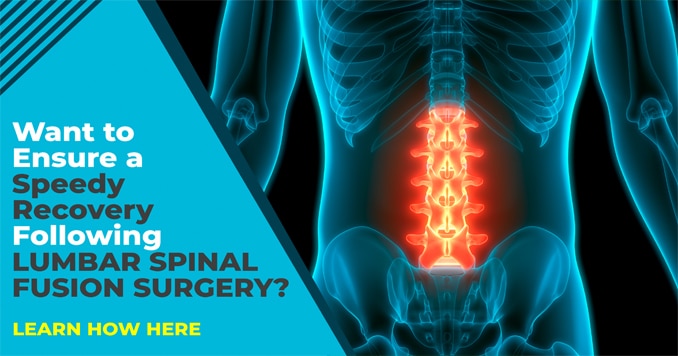
Few things are as debilitating as low back pain. It can interfere with your work, sleep, exercise and daily life. In fact, low back pain is one of the leading causes of disability worldwide. In some cases, you may need to consider lumbar spinal fusion surgery to get relief.
Lumbar spinal fusion surgery is a procedure that joins two or more bones (vertebrae) in your lower spinal column. This procedure is considered when you have problems with bone instability, deformity and/or pain.
Spinal fusion works by taking advantage of the natural bone healing process. During the surgery, pieces of bone (bone graft) or bone-like material is inserted into the space between your vertebrae. Metal plates, screws and/or rods may be used to keep the bones in place. Eventually, the bone pieces to fuse together to eliminate movement. Let’s take a closer look at this procedure, its indications and the best strategies for recovery.
Who Needs Lumbar Spinal Fusion?
In general, the indications for lumbar spinal fusion are:
- Fractured vertebrae that don’t heal correctly or that cause spinal instability or pain
- Severe spinal deformities, such as abnormal curvature of the spine (scoliosis)
- Arthritis that causes spinal weakness or instability with abnormal vertebrae motion
- Spondylolisthesis, which is a condition where one vertebra shifts forward abnormally on top of another bone; this can cause pain or a pinched nerve
- Herniated disk degeneration or removal can lead to spinal instability
In many cases, the abnormal position or movement of your vertebrae can cause pain. Pain may be due to the stretching or compression of nerves. However, some people who have X-rays showing significant bone displacement have no pain. Meanwhile, others who have minor displacement may have significant pain.
Lumbar spinal fusion is not recommended for all types of back pain. The best results are seen when symptoms are accompanied by a clear deformity or displacement of the vertebrae. If the cause of your pain isn’t clear, then your results might be less than optimal. In less certain situations, other treatments, such as physical therapy and/or medications, might be your best option.
What Are the Risks to Lumbar Spinal Fusion?
Like any surgery, lumbar spinal fusion surgery has some risks. Possible complications can include:
- Infection
- Inadequate wound healing
- Excessive
- Thrombosis (blood clots in the legs or lungs)
- Blood vessel or nerve injury
- Bone graft site pain or infection
Even though lumbar spinal fusion can help with unstable vertebrae, the procedure can lead to other complications long term. When two vertebrae are fused together, this places added stress on the vertebrae above and below the fusion. Over time, this can lead to an increased chance of arthritis developing in these bones.
How Is Lumbar Spinal Fusion Surgery Performed?
Lumbar Spinal Fusion Recovery: These days, many surgeons offer lumbar spinal surgery as a minimally invasive procedure. This means that a small incision — less than one inch — is made. Long, slender instruments are used to perform the operation. If your bone graft comes from your own body (autograft), it’s usually taken from the large bony part of your pelvis just above the hip.
The bone graft is placed between the bones that require fusion. Next, metal plates, screws, and rods may be used to stabilize the bone until fusion takes place. Fusion means that bony material grows between the vertebrae and the graft to create one solid piece of bone.
Depending on your particular situation, your doctor will decide if a minimally invasive approach is best for you. If not, you may require a more conventional surgery with a larger incision. Still, every surgery has its risks, even minimally invasive procedures.
What Are the Bone Graft Options for Spine Fusion?
Bone grafts for spinal fusion typically come in three forms:
- Autograft: Your own bone is used to form the bone graft; The most common donor site is the iliac crest which is the part of your pelvis just above the hip
- Allograft: Bone obtained from organ donor cadavers; this bone is sterilized and stored until ready for use in fusion surgery
- Bone graft substitutes: These can assist or replace the need for human bone in fusion surgery; tricalcium phosphate is sometimes used to provide added structure for fusion to occur more easily
What Are Bone Morphogenic Proteins?
Bone morphogenetic proteins (BMPs) stimulate bone growth and are generated naturally in the human body. These proteins can be placed between vertebrae to stimulate spinal fusion. BMPs can even create a fusion without the need for any bone grafts.
The discovery of BMPs is credited to Marshall Urist, M.D., an orthopedic surgeon, working in the UCLA Department of Orthopaedic Surgery in Los Angeles. This type of treatment is still relatively new, and it is indicated only in certain types of fusion procedures.
How Long Does It Take to Recover from Spinal Fusion Surgery?
Lumbar Spinal Fusion Recovery: With minimally invasive techniques, you may be up and walking the same day of the surgery. Complete recovery can take a few weeks to a few months. The timing may depend on other factors like the extent of the surgery, your age and any other health problems you have. You may notice a complete relief of back symptoms immediately after surgery. In other cases, the symptoms go away more gradually.
Bone fusion is a process very similar to healing a broken bone. This takes time, and complete fusion may not occur until three or four months after surgery. You don’t have to stay in bed for all that time, but you should follow precautions according to your doctor’s recommendations.
What Can I Do During Spinal Fusion Surgery Recovery?
Lumbar Spinal Fusion Recovery: Your doctor will give you specific instructions, but the most important thing may be not to bend or twist your back immediately after surgery. Even though plates, screws, and rods help keep things in place, limiting you back movement is still important. Getting out of bed may be difficult, so you want to log roll out of bed gradually.
During the recovery process, you should avoid all heavy lifting. About two to four weeks after your surgery, you will start physical therapy. This consists of gentle stretching and strengthening exercises. As therapy progresses, the intensity of the exercises will increase.
You should be able to drive for about two weeks post-surgery. After you have recovered fully, you may return to normal activity, maybe even competitive sports. Your full activity allowance depends on your symptoms and the evaluations of your physical therapist and surgeon.
Should I Follow a Special Diet After Spinal Fusion Surgery?
Lumbar Spinal Fusion Recovery: While there are no formal studies on specific diets after fusion surgery, most surgeons recommend plenty of calcium for bone formation. Some other foods that might be helpful to speed up your recovery are:
- Fiber: Not only is it heart healthy, but also fiber helps prevent constipation, which is common after surgery; try whole grains, avocados, berries, figs, and quinoa
- Lean meats: Protein helps healing tissue formation; skinless chicken, turkey, and fish are your best bets
- Foods that inhibit excessive inflammation may promote healing: Green leafy vegetables, broccoli, and blueberries are ideal in this category
- Immune boosters: May help prevent postoperative infections; try pecans, boiled artichokes, and blueberries; spices like cinnamon, oregano and ginger might have some benefit as well
- Water: It’s important to stay well hydrated after surgery; this also helps prevent constipation
Some studies suggest that too much coffee might weaken your bones. While you don’t have to stop coffee intake completely, you might want to limit it to one or two cups a day.
Summary
- Spinal fusion surgery joins two or more vertebrae together to limit movement.
- Not all back pain responds to spinal fusion.
- Bone grafts, metal plates, screws, and rods are placed during the surgery.
- Minimally invasive techniques may speed up recovery.
- Avoid twisting and heavy lifting after surgery.
- Physical therapy helps with post-surgical rehabilitation.
- A healthy diet may help speed up recovery and reduce complications.
- Complete bone fusion may take three or four months.
If you are looking for a comprehensive, yet simple to follow program that contains the exercises you need to know to recover from lumbar spinal fusion surgery, then check out the Lumbar Spinal Fusion Recovery Program, here!




